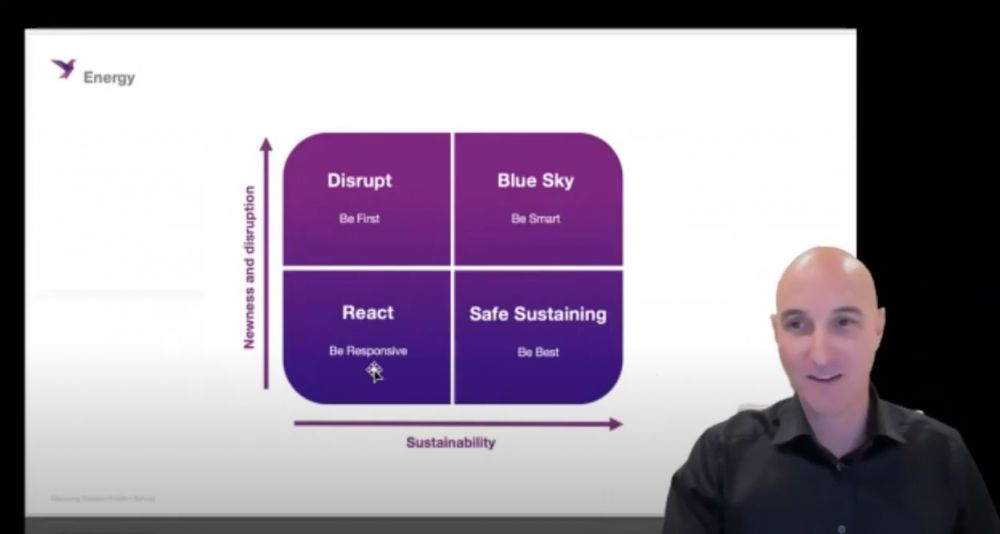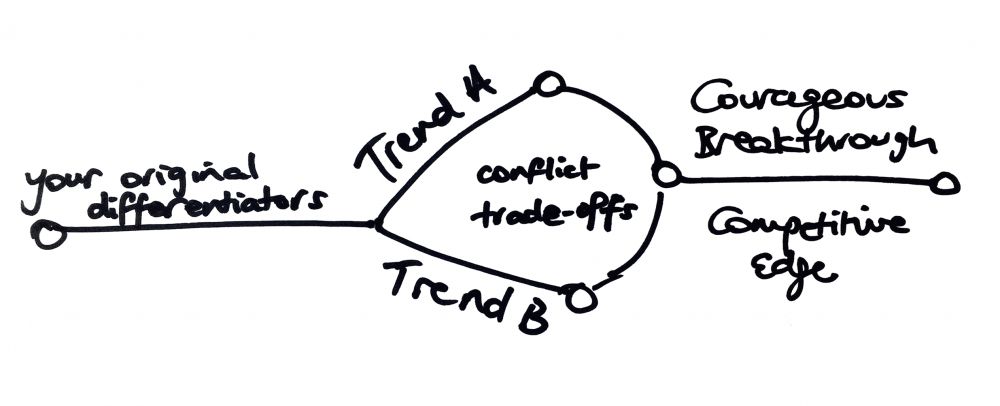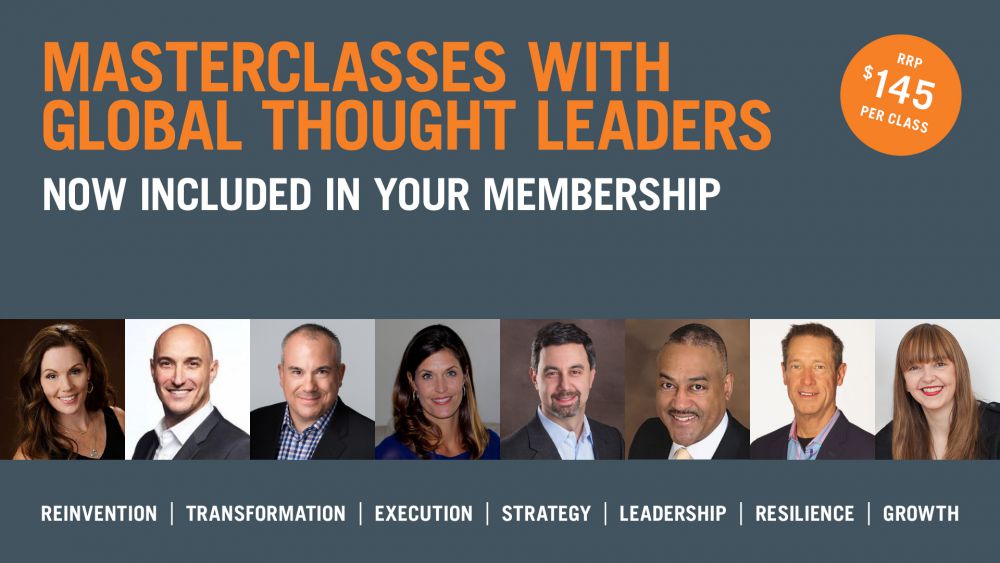How to look at disruption as a gift and lean into it

"Our mind must reach our destination before our life does." - quote from Kyle Hermans's Masterclass
Most products, businesses, industries and markets are experiencing unprecedented disruption. And, we now know how disruption is no longer a matter of “if” but “when”.
In his Time for Transformation masterclass Disruption Mapping , Kyle Hermans emphasised the importance of optimism and leaning into disruption. The co-founder and CEO of Be Courageous, a digital-first business consulting in the areas of culture, strategy, innovation, technology, and research, Kyle's clients include ExxonMobil, Google, PWC, Slack, Atlassian, TEDx, Facebook and HSBC.
The teacher at world-acclaimed Singularity University and member of the Forbes Business Council gave delegates a framework and critical tools to harness opportunity and unlock growth in disruptive times.
Here are some of the key points from the masterclass:
"If you lean in then you get learning agility," he said. "Courage the future....You want to look at everything coming at you as a gift."
Triangle of disruption framework
Mindset/Clarity (learning agility) – Energy/Purpose (resilience) – Action/Contribution (optimism) are the 3 points of triangulation of disruption.
If you have an interruption, welcome or unwelcome, ask yourself:
- Clarity: Am I clear about what is coming at me?
- Purpose: Is it in alignment with my purpose?
- Contribution: How do I lean in and contribute to it?
Staying optimistic is key. Instead of being fearful, say instead "We get to do it! Yes, it’s hard work, but what an opportunity to lean in."
- Nature shows us that species which lean into the patterns of what nature gives them survive and thrive. (Editor's note: Anyone seen the documentary My Octopus Teacher?)
- “History doesn’t repeat itself, but it does rhyme.” – yes things are different, but somewhere in the world, somehow, someone has probably solved the problem.
TRIZ method for "inventive problem solving" is a good starting point to look at what is incremental and what is truly breakthrough.
If you are looking for disruption (and this includes yourself, not just your company) – then always look at where the curve of normal behaviour, services or products starts to get “too normal.” The opportunity for disruption lies before this point, before the trend has been widely adopted.
In one exercise, masterclass breakout groups were tasked with identifying 2 distinct trends in conflict with one another.

Dawna's group talked about the trend of everyone wanting everything easy and cheap competing with a second trend of concern for the environment and sustainability. "Sustainable products and services might be more expensive and harder to find...ultimately we want both," she explained, on behalf of the group.
Kyle says this is an excellent discussion point for disruptive ideas:
- How do we get to do both? I don't want either/or - I want AND. So how can you deliver, or create this?
- What are the disruptive ideas when you have permission to ask such a question?
Simone's group chose the workplace - and how it is now disrupted. Simone said her group discussed how pre-Covid you'd go the meeting and you'd give it your full attention. but now you were doing 4-5 things as once.
Kyle says this brings up ideas around: What would the future of work/life balance look like? Is a 9-5 work schedule the right schedule? Are you more productive outside working hours? He says we can and should lean into inventing what this future could be....
He explained the saying "Our mind must reach our destination before our life does."
To create a future we want to live in, we have to feel what we believe that might feel like. Once you have the emotional response, you are provided with more creativity...if you are thinking of something more purposeful, it updates your thinking..
He says the people who disrupt....they are always updating their perspective, ideas, values, decisions, and purpose.
Is this the best it can be right now?
Ways to elevate our thinking in way that challenges our beliefs.
Most brainstorming sessions stop when the ideas are still rational and diverse. But some of the most amazing disruptions come from ideas that would have thought outrageous once.
To be disruptive thinking to brainstorming sessions, try thinking up ideas from rational to outrageous.
Try this ladder of ideas at your next brainstorming session:
- Rational
- Diverse
- Wishing (like a child would)
- Metaphor/analogy
- Irrelevant
- Illegal/immoral (Raise your hands if your parents told you not to get into cars with strangers! = UBER)
- Outrageous
To prompt even more creativity, explore the implication of an idea.
If I did this scenario, what would the situation be?
If you drop a disruption into a pond of still water, it makes ripples.
We need to ask ourselves, what would the implication of that be? And then the implication of that implication?
ABUNDANCE MINDSET
All of us are used to looking for the fragilities....Where am I going to get caught out?
Or, the scarcity...What's going to be in short supply?
Kyle suggests we instead try to lean into the areas that others are afraid to explore with an "abundance" exercise. What if there was an abundance of something?
For example, an abundance of the internet (Abundant 5G).
- What would be the first wave of implications (there are no right or wrong)?
- Perhaps you'd think "I'm untethered" - leading to remote living, I could then subscribe to stuff, I wouldn't need to be tethered to stuff.
- Perhaps more internet means you'd work smarter - "I can go anywhere" - leading to wanting to be more efficient - which could lead to microchips in my body - so who would manage my thought IP - mind police!!
- You can see where these things can go to.
Put the trend in the centre of a disruption mapping canvas....what is the implication of any trend that people think about/talk about?
- Go into the areas of outrageous and diverse thinking.
- Keep going. It's mind boggling what you start to uncover. There are thousands of ways that life can rollout.
- Then notice in yourself "what gets me lit inside?"
The masterclass broke into groups to put a topic in the centre of a disruption mapping canvas "...an abundance of...[something}..." and its implications.
Each team member began freewheeling ideas.
John's team tried ideation around "an abundance of no borders" - what if borders were open worldwide? Implications included trading anwhere, one legal system, sharing of a healthcare system, cultural differences, environment, sharing technology, looking after our citizens, one currency, one blockchain, on and on.....
David's team tried ideation around "an abundance of driverless cars" - the absence of car ownership, manufacturing opportunities, new IT company players, safety rules and laws, who's responsible, moral and ethical dilemmnas, positive implications for non-drivers, cyberattack and implications, security breaches, alcoholism (with no drink driving) and the power of Google.
It's like brainstorming but it's a disruption excursion
To bring this idea into the workplace:
- Write down the challenges you're trying to solve, and try the excursion exercise. It pressure tests your best thinking.
- Or, ask team members to arrive with a solution...then discuss what are the implication of the solution? Workshop crazy ideas that are illegal, immoral and absurd. You don't have to adopt them, but it taps into a creative part of team members more than sticking with the rational and diverse ideas.
- Compare "The risk of disrupting vs the risk of not disrupting' - what is at stake if you don't push a little bit further. Your idea could fail, but what if you didn't try?
- Use the Sustainable Development Goals as a starting point. What would happen if we solved these? It's a phenomenal exercise to see how things might go.
To sum up, push from:
- Defense to Offense
- Fear to Curiosity
- Rational to Outrageous
- Reactive to Proactive
- Fragile to Anti-fragile
- Scarcity to Abundance
The Growth Faculty has this year launched virtual masterclasses - the Time For Transformation series; especially designed for business leaders. We make learning and development easy and inexpensive by bringing your team the world's renowned thought leader. Ensure your team are trained to pivot, adapt and innovate in these unprecedented times. See who's up next.


 Australia
Australia
 European Union
European Union
 New Zealand
New Zealand
 United Kingdom
United Kingdom
 United States
United States
 Singapore
Singapore

